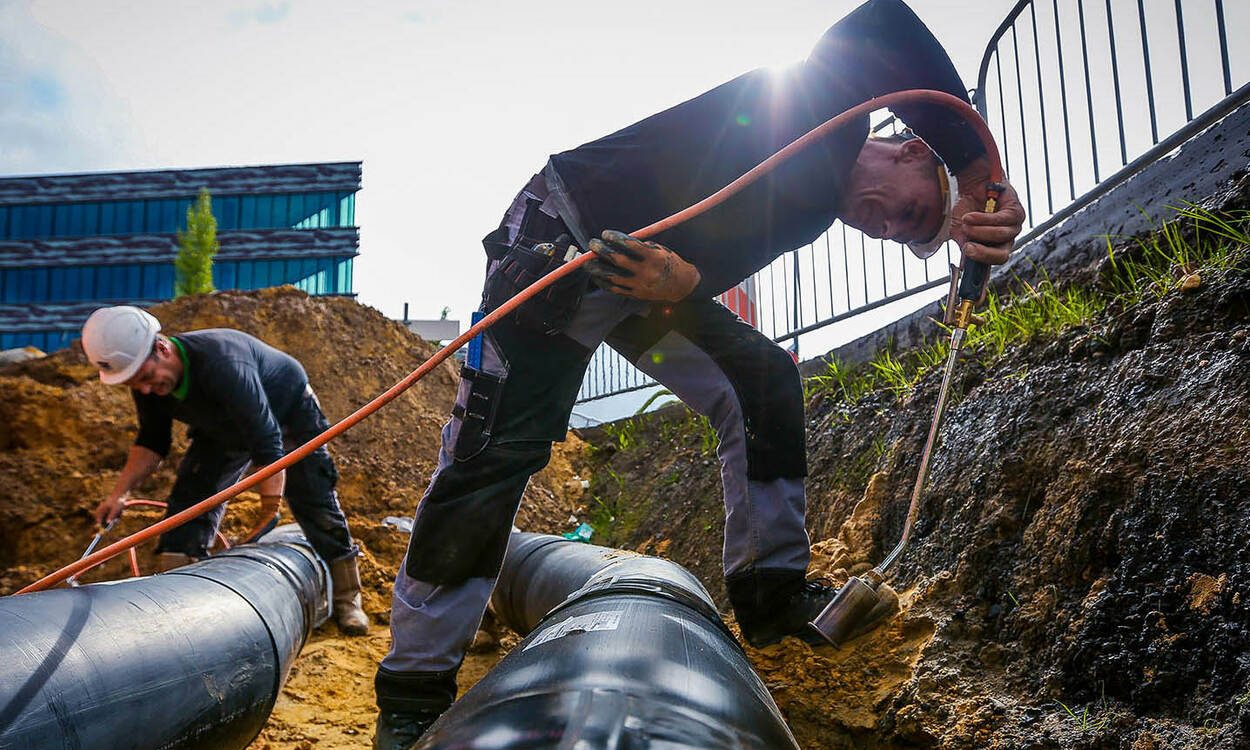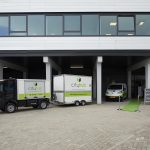Now that gas usage needs to be decreased, new innovative energy sources are needed to provide homes, offices and other buildings with warmth. One of those new energy sources is the circular district heating of Mijnwater B.V. What started as a manner to use groundwater in mines to heat and cool buildings in Heerlen, grew to one of the most innovative district heating plans of Europe.
For Minewater, WeLLDesign develops mass produced components to easily adapt homes that are connected to Minewater. The goal is to limit the effort for this adaptation. For that, installation units, suspended ceiling systems for pipes, installation partitions, etc. are developed based on platform thinking. If needed, these units, systems and partitions are prototyped on a one-to-one scale in a construction hall at WeLLDesign.
By the end of the 1960’s, the coal mines in Southern Limburg were closed. Since then, the shafts filled with groundwater that was heated by geothermal energy. In 2003 the district of Heerlen initiated a plan to, in the context of sustainable energy exploitation, do some test drilling in these mines. It was quickly realized that this mine water could be used to heat and cool buildings in a sustainable manner. Heerlen started a successful project based on thise principle: the Minewater project. Five locations were assigned for drilling. These locations were connected with each other by a main pipe to transport water to and from. In the city of Heerlen, 50.000m² of floor space in buildings is connected on this first mine water power plant.
A grand approach
The district’s project developed to a societal endeavor: Minewater B.V. ‘When the district’s project developed to an endeavor, the question was what should happen with this mine water and pipe system. There were a couple of buildings connected but to make it a bigger success, it needed to be exploited better’, explains Herman Eijdems, innovation manager at Minewater. Minewater had to exploit the energy above grounds smarter.
From mine water to city infrastructure
‘We have set up a new kind of city heating infrastructure. Maybe even the most innovative thermal power grid in Europe’, shines Eijdems. Minewater developed the first urban pipe network in Europe to deliver both heat and cooling to connected customers. When a building is being cooled, it simultaneously returns residual heat back to the grid and the other way around. With the city heating infrastructure the loop of warmth and cold delivery is closed. The energy is interchanged through underground drill cellars where the heat exchange units and pumps are located. The water in the mines act more as a large thermal battery than only as a green energy source. The CO² emissions of the connected buildings can be reduced by 65%.
Supply and demand
The city heating infrastructure of Minewater is based on three principles: demand-driven, circular and energy storage. ‘First of all the supply suits the demand. Imagine, it is 5 degrees Celsius outside but the building needs to be 20 degrees Celsius. You have to add 15 degrees. Burning gas to accomplish this, it requires a flame of 1000 degrees Celsius. To counter this energy wastage we only use sources of below 60 degrees Celsius.Heat pump systems make sure that the user always gets the energy that he or she demands.’
Closed loop
A lot of energy is wasted with heating or cooling of a building, explains Eijdems. When a building is cooled, for instance a large fan is placed on the roof that exhales warm air. ‘If we can salvage the energy from that warm air and reuse it, theoretically we only need to convey a third of the original external energy. We use that for cooling. And it is already applied. The Arcus College in Heerlen runs on the heat from the data center of retirement fund APG.’
Store excess energy
Also, Minewater can store electricity in buildings and under ground. ‘Suppose that there is excess energy generated because the wind blows hard and the sun shines brightly at the same time. With a heat pump you can store energy as warmth in buildings and water. When the sun is gone, this warmth can be used again.’
Not an invention, but a discovery
‘The funny part is that we don’t make use of exciting new innovaties , says Eijdems. ‘Heat pumps, pipes and storage chambers are techniques that are around for already 50 years. But we have connected all those elements in a new way. We didn’t invent anything, but discovered something beautiful.’ Mine water can also be used in other former mining areas to heat and cool buildings. besides that can the hybrid city heating infrastructure that Minewater has developed be applied in every city.
Looking ahead: we need to grow. Hard.
That discovery is being embraced by the region. PALET (a cooperation between eight districts in Southern Limburg) burdened Minewater B.V. with the objective that by 2040 all buildings in these districts need to be connected to the city heating infrastructure of Minewater B.V. ‘Our objective is not to make profit, but to maximize sustainability. This means that we have to connect 25.000 homes every five years. That is a huge task, demanding ourselves to grow hard and fast.’
Adaptations in all residences
That is a challenge for the company, since every residence that need to be connected also needs to be adapted. ‘Usually, city heating starts at a large power plant. The whole city is controlled via that plant. With our approach, every end user has a small heat pump installation. For these particular adaptations we have to converse with housing corporations. Sometimes we get the question from people: “Do we have to make adaptations in all these residences?” Yes, that has to be. An energy transition is comprehensive. But our city heating infrastructure uses the low-hanging fruit on both district and building level. That is the reason why residence adaptations with us are much cheaper than with other ways to decrease gas usage.’ An extra benefit is that all components are developed in such a way that they can be manufactured industrially. That is where WeLLDesign excels in.
Minewater B.V. used to get its energy from mine water. Currently the mines are just a security stock. Mine water is a new kind of city heating infrastructure that due to the development of the first self-sustaining piping network in Europe both heat and cold can deliver to connected customers. When a building cools down, there is residual heat. The network of Minewater B.V. makes sure that this residual heat and cold is exchanged through heat pumps that are placed in underground vaults.
in this way CO² emissions of connected buildings can be reduced by 65%. In 2018, the company supplied 800.000m² in buildings with heating and cooling. The region embraces with PALET the city heating infrastructure of Minewater B.V. with the objective to have all residences the eight district of Souther Limburg connected by 2040.



